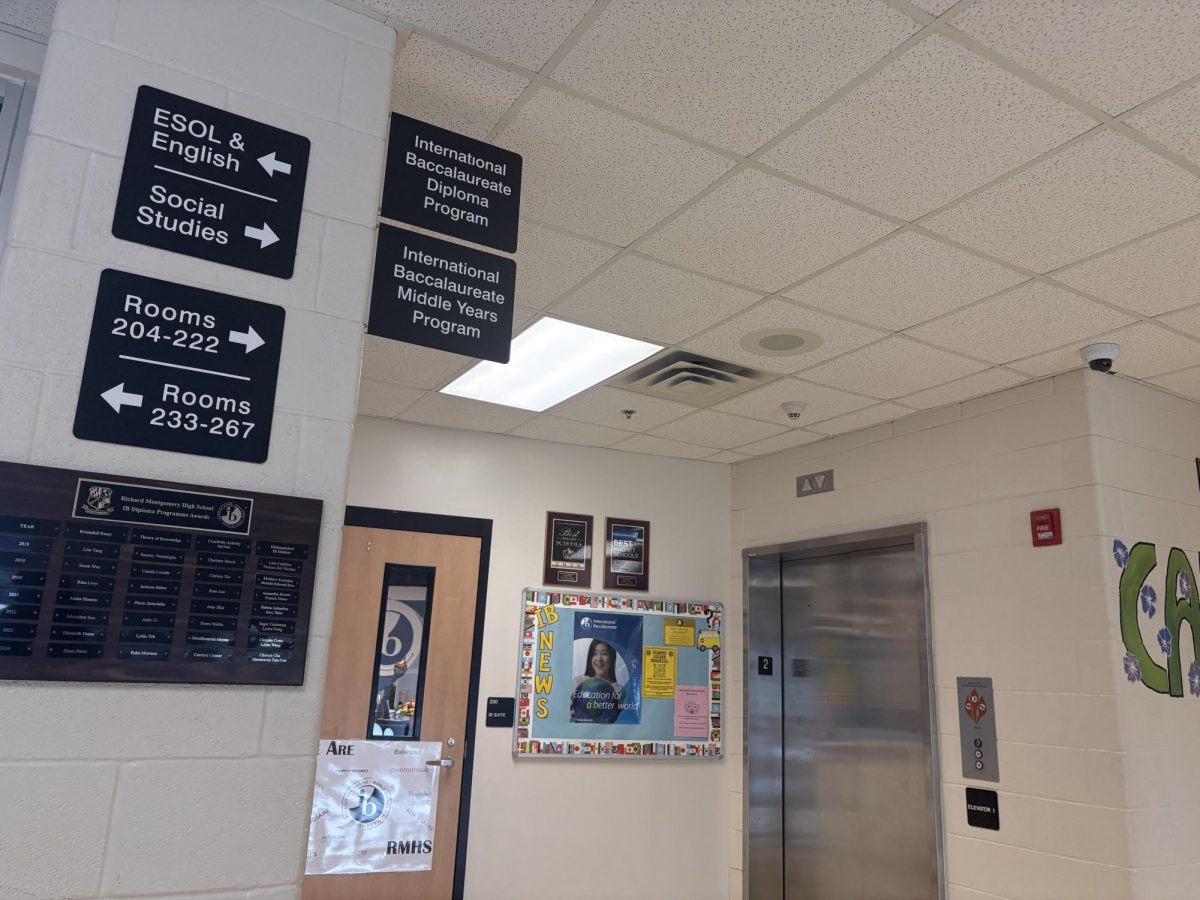When you hear the words ‘college’ or ‘university,’ a few things might come to mind: classes, parties, new experiences, freedom and perhaps most notably, a college degree. Many view attending a university as an essential step toward adulthood where students gain the necessary social and career-focused skills to succeed in the modern American workplace. According to a report by the Pew Research Center, “roughly six-in-ten (62 percent) college graduates with two or four-year degrees think their degree was very useful for helping them grow personally and intellectually, while roughly half think it was very useful for opening up job opportunities (53 percent) or for providing them with useful job-related skills and knowledge (49 percent).” Many adults look back at their college experience fondly; however, the unique challenges that high school students face are less often acknowledged. While RM does offer resources through the College and Career Center, teachers at RM can and should play a larger role in mitigating the inherent stress of applying to college.
In diverse, affluent areas such as Montgomery County, there is a high social and cultural emphasis on pursuing higher education. Specifically, many high school students find themselves facing pressure from their families, peers and academic environment to go to elite schools to have a ‘bright’ future. Many have come to recognize that simply graduating from high school is not enough to attend a highly selective school, as tens of thousands of applicants from around the world compete for the few thousand spots available in the ‘Ivy League,’ the most prestigious group of U.S. universities.
Other highly-ranked institutions, both public and private, are similarly enticing to many students: for their rigorous programs, research opportunities, high levels of career readiness among graduates and notable alumni who go on to serve as leaders and innovators in the industries of their choice.
THE PROBLEM
The word “college” enters many RM students’ vocabulary as early as the beginning of freshman year. With students being introduced to AP classes as a way to earn college credit, rushing to join clubs at the yearly Club Fair and meeting with counselors to plan courses, the pressure surrounding the college process starts young, often in ninth and tenth grade. “I heard people talking about their ‘dream schools’ when I first started at RM, which I didn’t understand, because how do you know what you really want so early?” junior Norman Meyer said. Students begin assembling their course plans for the rest of their high school careers early, selecting specific classes often with their college application portfolio in mind. According to the College Board, “students should know that the courses [they] take matter. That’s because college admissions officers want to see a solid foundation of learning you can build on in college.”
This expectation can lead students to worry that they are taking the “wrong” classes and can cause them to second-guess taking classes they are genuinely interested in because they might not sound as ‘impressive’ as other AP or IB courses offered at RM. This pressure can lead students toward a less fruitful high school experience. “Kids who are younger are going to try to select courses that are challenging or that point them in the direction of stuff that they’re interested in. And of course, you should think about that. But, you know, ninth and tenth graders shouldn’t be asking themselves, ‘Well, what will colleges say?’” English teacher Bonnie Peyer said.
Students tend to create rigorous course schedules for themselves to have a chance at getting into top universities. When school sports, clubs and other extracurricular activities are taken into account on top of the academic workload, students’ stress levels only continue to rise. “I definitely felt a little bit more stressed because I wanted to do well and play well during lacrosse season, and I also have to turn in all of my work and begin studying for all of the AP tests,” senior Peter Kim said.
Students can fall into harmful and mentally draining habits when they overload their schedule with AP and IB classes. To stay on top of their work, many students find themselves losing crucial hours of sleep at the expense of their mental health. For this reason, junior year is often considered the most difficult year of high school. “Well, that’s the time where you’re probably taking the SAT, you have the most access to AP classes, and I guess you’re beginning to think about college,” Kim said.
Even with these jam-packed schedules, admission is never guaranteed, resulting in only more stress among students. An increase in applicants lowered the average acceptance rate at the nation’s top 51 schools from 35.9 percent in 2006 to just 22.6 percent in 2018. “You put all of this work in, you find extracurriculars to be a part of and study for months for the SAT or ACT, all on top of keeping up with your school work, just to not be accepted to so many schools,” junior Max Zeballos said. This hopelessness that some juniors feel is a result of years of high expectations and the dim reality of the current college admissions system: that top universities have to choose from thousands more qualified candidates than they can admit, and the choice is left up to a select few individuals on the school’s admissions committee.
A Forbes article further explains that Ivy League acceptance rates have plummeted to ‘historic lows.’ With a lack of knowledge about college acceptance rates, one might guess that low acceptance rates have been caused by schools arbitrarily becoming more selective. In reality, an increasingly large, diverse and competitive pool of applicants is a more relevant factor that sets today’s bar higher than ever when it comes to college admissions.
A recent study by Frontier Psychology reveals that 50 percent of high school students are chronically stressed. Students at high-performing, academically rigorous high schools like RM are pressured to build the most competitive resume. The driving force behind the development of these schedules comes from students’ fear of rejection and pressures to go to a top school.
For better or worse, many believe that a degree from an elite institution like Harvard or Stanford is the only path to success. To stay competitive in the rigorous selection process, students have become increasingly focused on living for the future as opposed to in the present, all while continuously, compulsively comparing themselves to others.
This “grind” culture that students have enlisted themselves in throughout the country is only hurting their academic performances. In a recent study, NIH cited that measures of perfectionism have been shown to correlate with academic burnout, testing anxiety and procrastination. Sometimes, students load up their extracurriculars with evidently meaningless passion projects which they do to impress admissions officers. Contrary to popular belief, the Harvard Graduate School of Education recommends that students limit the extracurriculars they list to show quality over quantity. Over 50 admission deans have endorsed this report, wanting to see what students are truly interested in rather than how much a student can do outside of the classroom.
“There are tons of videos on TikTok of people going over their ‘college resume’ and they have tons of extracurriculars and insane grades,” junior Aaron Logsdon said. “It just adds to the pressure to do everything we can in high school to get into a good college instead of enjoying ourselves.” Throughout the school year, college-focused videos flood students’ social media feeds. These videos can feature a variety of themes: acceptance videos with teens and loved ones celebrating, college students and applicants showing off their grades and test scores and professionals offering their ‘hacks’ when it comes to college admissions. Considering the prominent nature of social media for teens worldwide, the well-known saying “social media is a highlight reel” holds true for college-related videos students watch online.
When students exclusively post their acceptances and selectively feature impressive parts of their application, it sets unrealistic expectations for viewers, building low confidence and anxiety. RM, along with other high schools in the area, creates a “commits” Instagram account for each class, where graduates submit their post-high school plans and get a flier sharing their accomplishments. “These commits pages are great for celebrating our seniors,” Logsdon said. “However, seeing so many people get into great colleges, especially within the IB program, leads to the unfair assumption that we ourselves have to do the same thing.” Social media as a whole fails to reveal the whole picture, but especially with the college admissions process, is unhealthy and tends to be addictive for students.
THE SOLUTION
There is no better way to manage college-related anxiety than in the learning environment where it builds up yet is rarely addressed openly: the classroom. Just as teachers play a prominent role in their students’ education and academic success, they can and should address the unspoken ‘elephant in the room’ that weighs on students’ mental and emotional health. “We all know that there are certain times of the year where stress is high and kids are preoccupied. So we try to account for that, like, we can’t just put the brakes on all the teaching, but we try to keep it in mind,” Ms. Peyer said.
Having open conversations about student experiences and emotions in the classroom can help reassure students that they are not alone in facing what can feel like an uphill battle. Each year, Ms. Peyer shows her seniors a slideshow that aims to calm their worries about college. “What was really bothering me was seeing how much of [students’] self-worth was tied up in the college process. I just thought that was too much pressure on people… I really wanted to be one of the voices telling them, you know, that you are inherently worthy…you don’t have to get into a specific school to be valuable as a person,” Ms. Peyer said.
The underlying causes surrounding college admissions stress, however, do not magically disappear. “Just one 15-minute reminder from me is not going to undo years and years of conditioning and culture and social pressure,” Ms. Peyer said. To ease students’ worries, more direct action needs to be taken. RM administration and teachers should create more opportunities in the classroom for candid, genuine conversations to help students truly feel the support of the RM community. These conversations do not need to be reserved for seniors either; students at every grade level can benefit from conversations that acknowledge current social pressures and lead them to develop their academic careers genuinely—with intention and purpose, not with ‘what colleges want to see.’
RM’s College and Career Center provides students with many different resources, ranging from SAT prep books to hosting visits with college admissions officers, and students of all grade levels should actively take advantage of these resources. To learn more about the schools they might be interested in, students can use the Naviance platform’s College Search feature. “There’s so many resources, not only with myself, but there are counselors that are available here. Most of our college reps that do come into our building are the reps that read your application,” College and Career counselor Lisa Miller said. “These are your best points of contact.”
With these resources, Ms. Miller is confident that every student who wishes to pursue a college career can find a school that is a good fit. There are many colleges and universities that students can be matched and put in contact with through the College and Career Center. “There is a place for you. So my biggest advice is to stay calm. We’re here to help you and there is always something for you to look into and research to do,” Ms. Miller said. “So stay calm and believe in yourself. You got this.”
Managing your stress levels regarding college preparation isn’t completely an extrinsic issue. “Well, I don’t think you can avoid the stress, but I think you can limit it by making sure you do stuff early and you don’t let anything slip through the cracks and end up becoming a last-minute task,” Kim said. Without a doubt, staying organized can help students feel less stress toward college applications. Students should utilize organizational tools to set goals in advance, such as building timelines for individual steps of the college preparation and application process. Planning ahead for standardized exams and applying for summer programs during the school year can help reduce future stress.
After countless long nights spent studying away into the night, offers of admission from schools around the world finally pop up in the email inboxes of RM seniors, and a wave of relief washes over them. Four years spent studying for test after test, refreshing the StudentVue gradebook as quarters end, anxiously asking teachers to round up their letter grade, and fighting for every hundredth of a percent—it all paid off. Towards the end of every school year, RM seniors look ahead to their bright futures and reflect on their time in high school. They survived RM’s challenging classes, competitive atmosphere and high expectations—and you will too.







